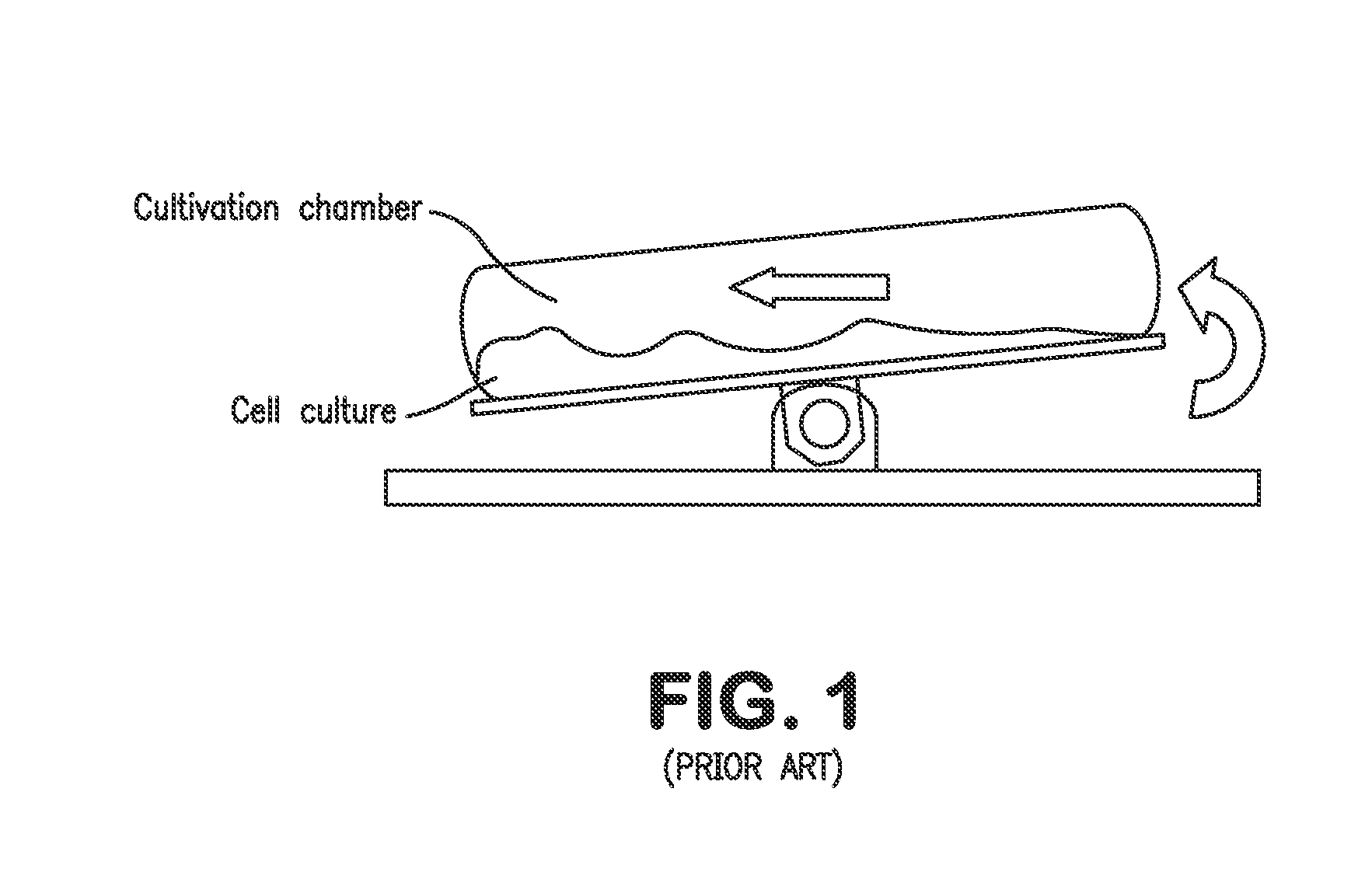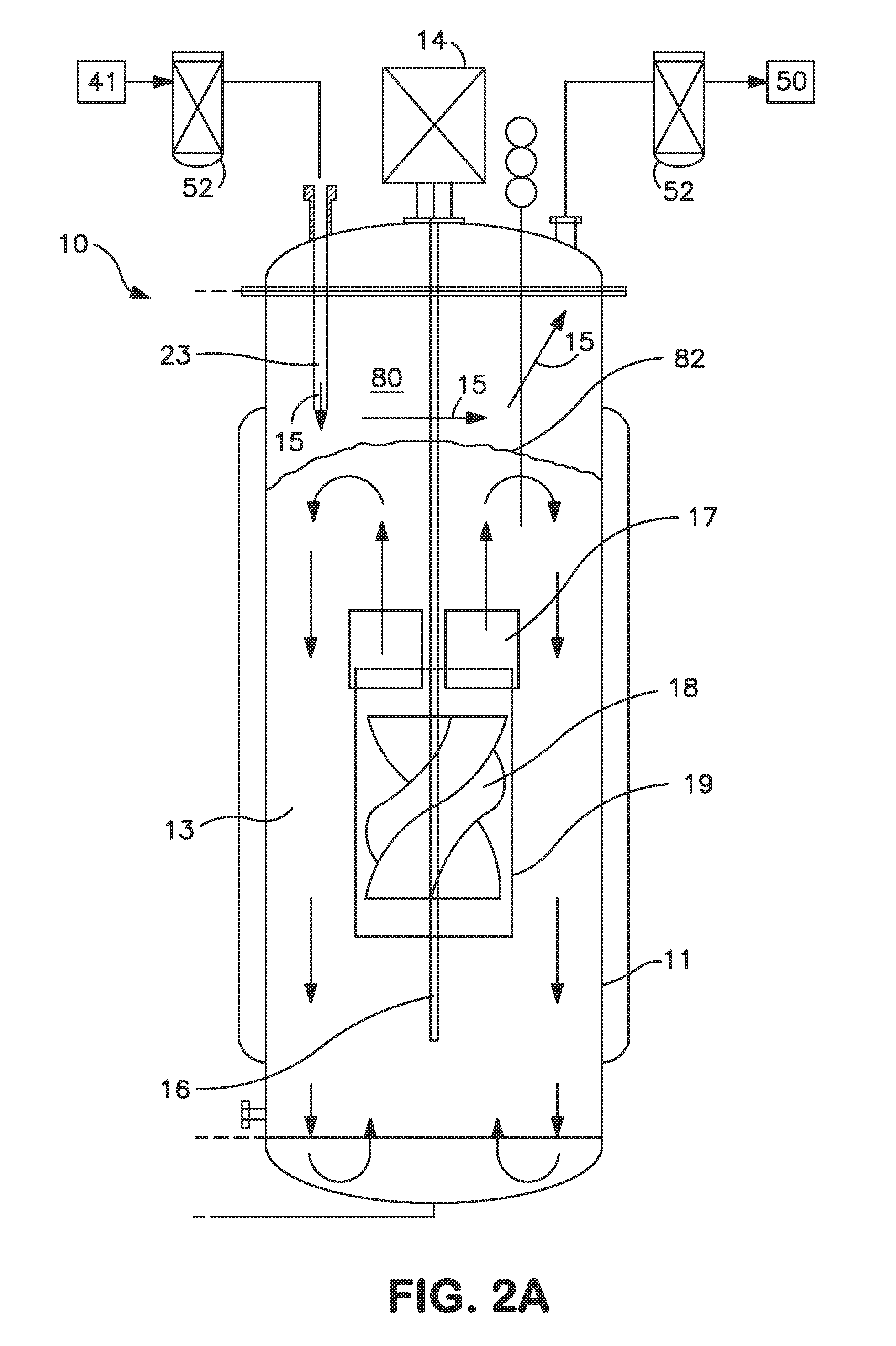As a matter of fact, many commercial bioreactors do not even have the means installed to measure dissolved carbon dioxide and / or osmolality levels in-situ, let alone a means to control and optimize those parameters.
Depending on the scale of the commercial operation—
ranging from hundreds up to 25,000 liters of bioreactor volume—scale-up, optimization and control of the process
pose different challenges.
At commercial scales above about 1,000 liters, simultaneous and independent control of dissolved carbon dioxide and osmolality levels becomes difficult if not impossible with current best available technologies and methodologies.
Disadvantageously, air-sparging and agitation of the culture medium or solution may result in foaming and shear damage to the mammalian cells which adversely impacts cell viability.
First, adding
sodium bicarbonate to adjust the pH of the solution, results in an increase in osmolality level.
It is known in the art that increased levels of either dissolved carbon dioxide or increased levels of osmolality have adverse or negative impacts on
cell density or yield.
However, the combined or synergistic effects of carbon dioxide and osmolality levels are not well understood.
Removing the dissolved carbon dioxide from a
cell culture thus becomes difficult as most
mammalian cell cultures take place at pH levels in the range of 6.5 to 7.5.
The dissociated
bicarbonate ions are not easily removed and generally must be recombined into free carbon dioxide before they can be stripped out of the solution.
Any addition of
sodium bicarbonate to balance the pH will also increase the equilibrium dissolved carbon dioxide concentration or
saturation level in the solution, making it more difficult to remove the carbon dioxide physically.
However, gas sparging in agitated tanks results in adverse effects to the cell culture process.
In particular, the gas-bubble breakage at the tip of the rotating
agitator is a source of high
shear rate that damages mammalian cell membranes, often sufficiently to cause cell death.
Even when damage is sub-lethal, cell productivity is compromised in the period that the damaged membrane is repaired.
Bubble breakage behind the rotating impeller will have a major role in cell death.
Small shading vortices formed behind the impeller will also damage cells to a lesser extent.
Downward pumping axial impellers generate vortices that entrain gas from the headspace into the body of the agitated liquid, resulting in
gas bubble formation.
As mentioned above, gas bubbles have a negative
impact on
cell growth in that the force of a breaking
gas bubble is sufficient to damage the outer membrane of a mammalian cell, and can cause it to burst.
Therefore, conventional radial impellers and downward pumping axial impellers are not generally suitable for promoting gas exchange between the liquid surface and the bioreactor headspace as a way to remove carbon dioxide from the cell culture medium.
During scale-up from a bench or
laboratory scale bioreactor to a production or
commercial scale bioreactor, a productivity loss of up to 60% has been observed; excessive levels of carbon dioxide at the larger scale is the suspected cause of such productivity loss.
Carbon dioxide removal via
air sparging tends to be very effective in laboratory or
bench scale bioreactors (e.g. less than 10 Liters of working volume) but is less effective in larger scale commercial bioreactors for at least three reasons: (i) the
surface area to volume ratio is reduced, which further limits surface gas exchange; (ii) higher hydrostatic pressures in a
large vessel increase carbon dioxide
solubility; and (iii) larger vessels contain more cells and the resulting increased need for sparged gas to supply
oxygen leads to more bubbles, which create more foam at the surface and further inhibit surface gas exchange.
Another
disadvantage of foam created by
air sparging into a rotating
agitator is that cells become trapped on the foam layer where they are depleted of nutrients.
Foaming also limits the operable volume of the reactor, as foam overflow can damage the integrities of the biological filters that prevent process
contamination.
Although anti-foaming agents are used, such agents have many undesirable effects.
For example, anti-foaming agents can contaminate the biological products and their removal may require further downstream purification steps.
Also, gas bubbles created by sparging can burst at the liquid surface; this is often more damaging to cultured cells than shear due to the
agitator.
However, both measures reduce the amount of carbon dioxide that is removed which in turn inhibits
cell growth and reduces viability.
These disadvantages are particularly challenging to overcome in large, commercial-scale bioreactors where the
shear rate goes up substantially with the
diameter of the impellers.
Some bubble free systems with membrane
aeration have been proposed, but these have demonstrated only limited success even at small scales.
The surface area needed for sufficient gas exchange has limited the size of this bioreactor to less than 500
liter working volume which is not suitable for large,
commercial scale systems.
 Login to View More
Login to View More  Login to View More
Login to View More 


